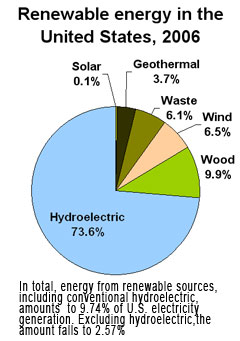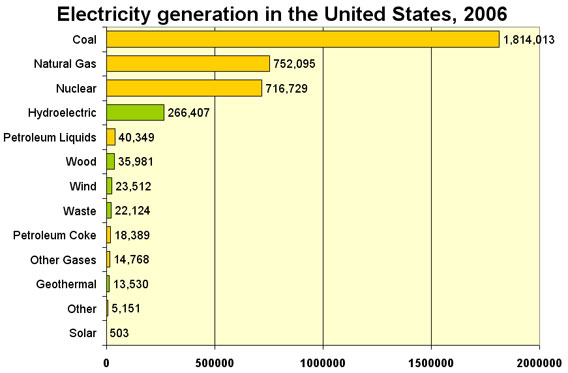$100 billion invested in renewable energy in 2006
$100 billion invested in renewable energy in 2006
mongabay.com
June 20, 2007
$100 billion poured into renewable energy and energy efficiency in 2006, a 25 percent jump from 2005, reports a new analysis by the UN Environment Programme (UNEP).
UNEP anticipates the trend will slow to $85 billion this year.
UNEP says that investors put $71 billion into the sector in 2006 while another $30 billion came from mergers and acquisitions, leveraged buyouts and asset refinancing.
The report notes that while renewable energy sources are presently only 2 percent of the installed power base, they now account for about 18 percent of world investment in power generation

Chart showing renewable energy production in the United States for 2006. In total, energy from renewable sources, including conventional hydroelectric, amounts to 9.74% of U.S. electricity generation. Excluding hydroelectric, the amount falls to 2.57%. Figures from the Department of Energy’s (DOE) Energy Information Administration (EIA). Chart created by Rhett A. Butler, mongabay.com. |
“One of the new and fundamental messages of this report is that renewable energies are no longer subject to the vagaries of rising and falling oil prices—they are becoming generating systems of choice for increasing numbers of power companies, communities and countries irrespective of the costs of fossil fuels,” said UNEP Executive Director Achim Steiner. “The other key message is that this is no longer an industry solely dominated by developed country industries. Close to 10 per cent of investments are in China with around a fifth in total in the developing world. We will need many sustained steps towards the de-carbonizing of the global economy. It is clear that in respect to renewables those steps are getting underway.”
The report cites high oil prices and concerns over global warming and energy security as key drivers of the trend.
“Growing consumer awareness of renewable energy and energy efficiency — and their longer term potential for cheaper energy, and not just greener energy — has become another fundamental driver,” states the report. “Most importantly governments and politicians are introducing legislation and support mechanisms to enable the sector’s development.”
During 2006 venture capital and private equity investors in put $2.3 billion into biofuels, $1.4 billion into solar and $1.3 billion in wind. About 40 percent of renewable energy investment went into asset financing of new generation capacity. 9 percent of global investment occurred in China, 70 percent in the U.S. and E.U., and 5 percent in Latin America. Africa lagged far behind the rest of the world in attracting investment.
The report also highlighted gains from energy efficiency, which has been helping drive the observed decline in global energy intensity since the 1970s.
“Since 1990, energy efficiency has met one-half of all new demand for worldwide energy services,” stated a release from UNEP. “These savings — 3 billion tonnes of oil equivalent — have a value of $6 trillion if an average oil price of $27 is assumed. The challenge is to accelerate energy intensity improvement to levels of 2% or above, which compounded to 2030 would mean a 61% improvement from today.”

Chart showing total energy production in the United States for 2006. Renewable energy sources are in green. Figures from the Department of Energy’s (DOE) Energy Information Administration (EIA). Chart created by Rhett A. Butler, mongabay.com. |














